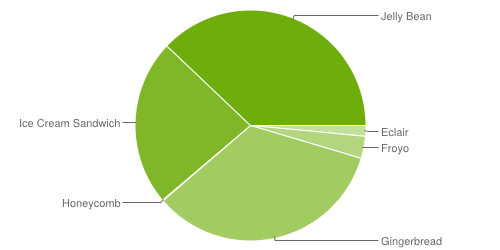Android Jelly Bean image via Android on Google+
Jelly Bean, Google’s latest version of Android, has finally become the mobile operating system’s most popular release, but more than one-third of users are still using Gingerbread.
About a year on from its initial release, Jelly Bean has finally reached the top of the Android charts, with 37.9pc of the market share.
Second in line, and the former No 1, is Gingerbread with 34.1pc. This Android version was first released in December 2010 and saw encouraging levels of adoption, but many of these devices haven’t been updated since.
Ice Cream Sandwich, a more recent version than Gingerbread (note Google’s alphabetical naming system for the clues) rests in third with 23.3pc of the market.

Chart of data collected during a 14-day period ending on 8 July 2013, excluding any versions with less than 0.1pc distribution (via Android Developers Dashboards)
Despite providing updates to Android every six to nine months, delivering the latest versions of Android to devices is a slow and painful process. This is not an issue with Android rival iOS, as Apple ensures that updates are rolled out in a timely fashion. Android’s heavily fragmented market, with a wide range of hardware from numerous OEMs means updates often arrive months after their release, if at all.
Much of the blame for Android’s delayed updates has been put at the foot of manufacturers and operators, whose focus is on pushing new devices, which often means that older models are left by the wayside. Just last week, HTC announced that its HTC One S – a phone that is just 16 months on the market – will no longer receive updates.